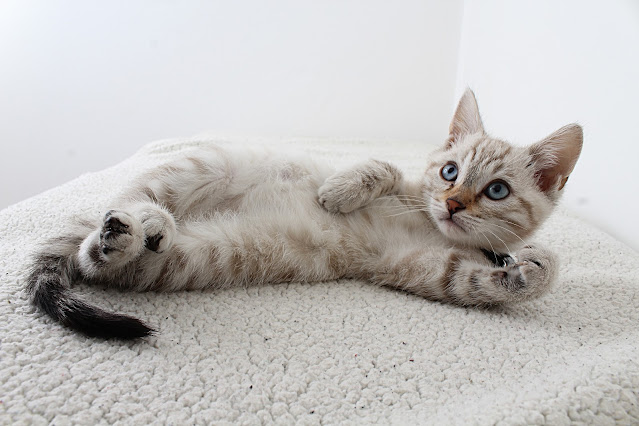Find the best cat food and supplies from Amazon >>
Get ready to learn the language of cats! You'll know when your cat is happy, scared, or angry. You'll also discover how to ensure your feline friend feels safe and secure in their home.
Cats use a variety of vocalizations to communicate
Meowing: Cats meow to communicate with humans and other cats. The meow can mean different things depending on the tone, such as a greeting, a request for food, or a plea for attention.
Purring: A cat's purr is usually a sign of contentment and comfort. It can also signal that the cat is feeling safe and secure.
Hissing and Growling: This vocalization usually means the cat feels threatened or afraid. It's essential to respect a cat's space if it begins to hiss or growl, as it is likely trying to protect itself.
Trilling: Trilling is sound cats make when they are excited or playful. It can also be used as a friendly greeting when cats meet.
Chirping: Chirping is a short sound that cats make when they spot prey or want to get their owners' attention. It is similar to meow but much quieter and more high-pitched.
Find the best cat food and supplies from Amazon >>
Body language is important
When it comes to understanding cats, body language can tell us a lot about how they're feeling and what they're trying to communicate. Cats have a variety of subtle cues that indicate their emotions. They use their tails, ears, and eyes to signal their feelings.
If your cat's tail is held high and the tip twitches, they will likely feel confident or curious. A low tail indicates fear or aggression, while a tucked tail signifies submission. Cat ears are another indicator of mood; if your cat's ears are flat against their head, they may feel defensive. Erect ears show interest or alertness.
Grooming behavior like licking or scratching may suggest that your cat feels comfortable and relaxed in its environment.
Cats also use eye contact to express themselves. Direct eye contact with widened pupils is a sign of aggression or fear. But if your cat has relaxed eyes and looks at you with half-closed lids, that's a sign of trust and affection.
Lastly, rubbing against your legs or objects around your home may mark their territory or express love for their owner. With these simple cues, you can start to form a bond with your beloved pet and gain an understanding of its needs and behaviors.
By paying attention to these body language cues, you can better understand your cat's moods and what they're trying to communicate.
Find the best cat food and supplies from Amazon >>
The scent is another way cats communicate
Cats have a powerful sense of smell and use it to communicate with other cats. When a cat rubs his face against objects, he leaves his scent behind to mark the territory. Cats also have scent glands in their cheeks and paws to spread their scent.
Cats also use scent to recognize one another. Cats that have spent time together will rub their faces together to swap scents and show affection. This is also why cats may sniff each other when they meet. They are taking in the other cat's scent and getting a better understanding of who the other cat is.
Cats also use scent to communicate feelings. When cats feel scared, angry, or happy, they secrete a pheromone that other cats can detect. Depending on the situation, this could be used to either express submission or aggression.
In short, the scent is a critical way cats communicate with each other. Cats can tell much about each other and their environment by picking up on scents. Understanding how cats use scent to share can help us better understand our feline friends.
Find the best cat food and supplies from Amazon >>
Cats also communicate through touch
Cats use a range of touches to communicate with other cats and humans. When they rub against you, they're marking you as part of their territory, a sign of affection, and a way to spread their scent. They may also head butt or tap your legs with their heads. This is a sign of acceptance, love, and trust.
Cats can be more affectionate when it comes to touch, too. They may purr and knead with their paws when happy and relaxed. When your cat curls up in your lap or cuddles next to you, it's a sign that he or she is content and comfortable around you.
Kittens also use physical contact to bond with each other and their mother. Grooming one another helps kittens strengthen their social bonds and also teaches them about grooming etiquette.
How your cat touches you tell you a lot about his or her feelings. If your cat is agitated or unhappy, they may bite or scratch you. If this happens, it's best to back away and give the cat space. On the other hand, if your cat rubs against you, it's usually a sign of affection and comfort.
Cats are complex creatures with many ways of communicating with each other and us. Touch is just one of the ways cats express themselves and show us how they feel. Understanding your cat's body language can help you better understand their needs and improve the bond between you and your pet.
Find the best cat food and supplies from Amazon >>
